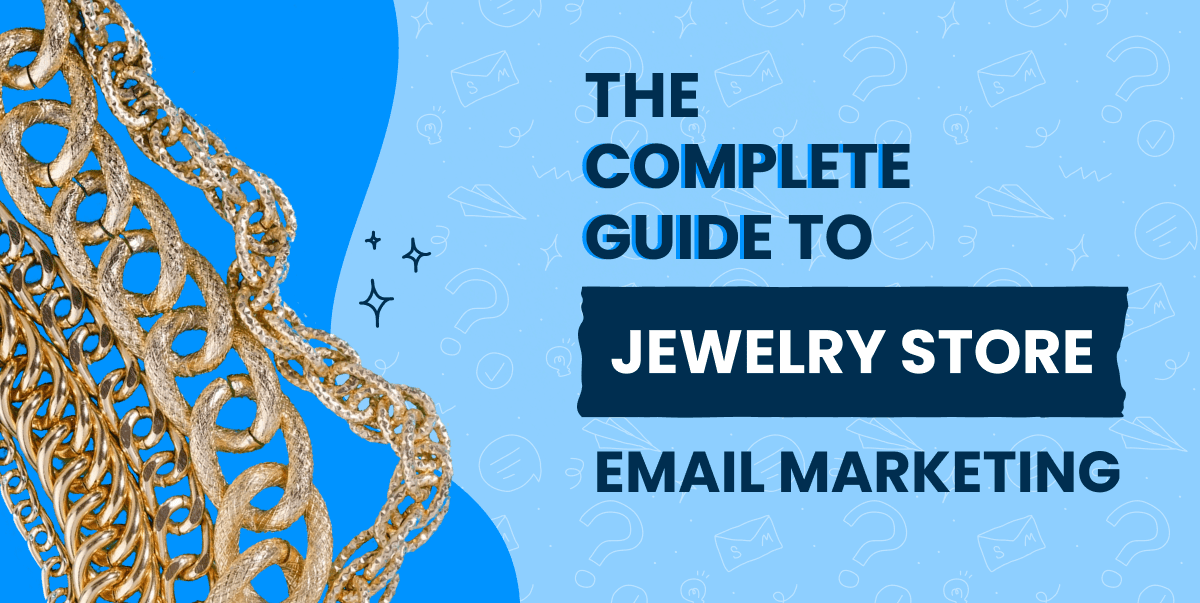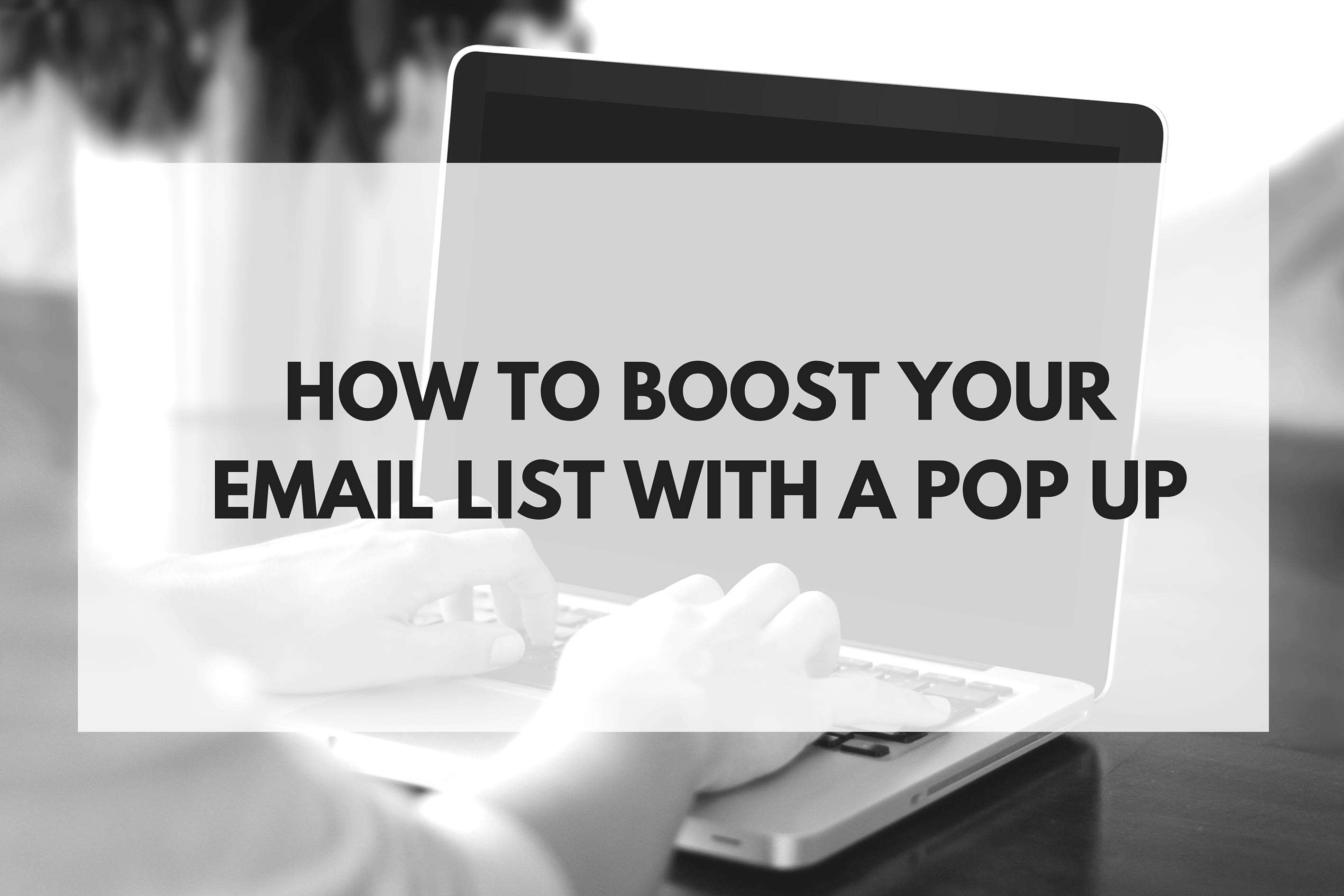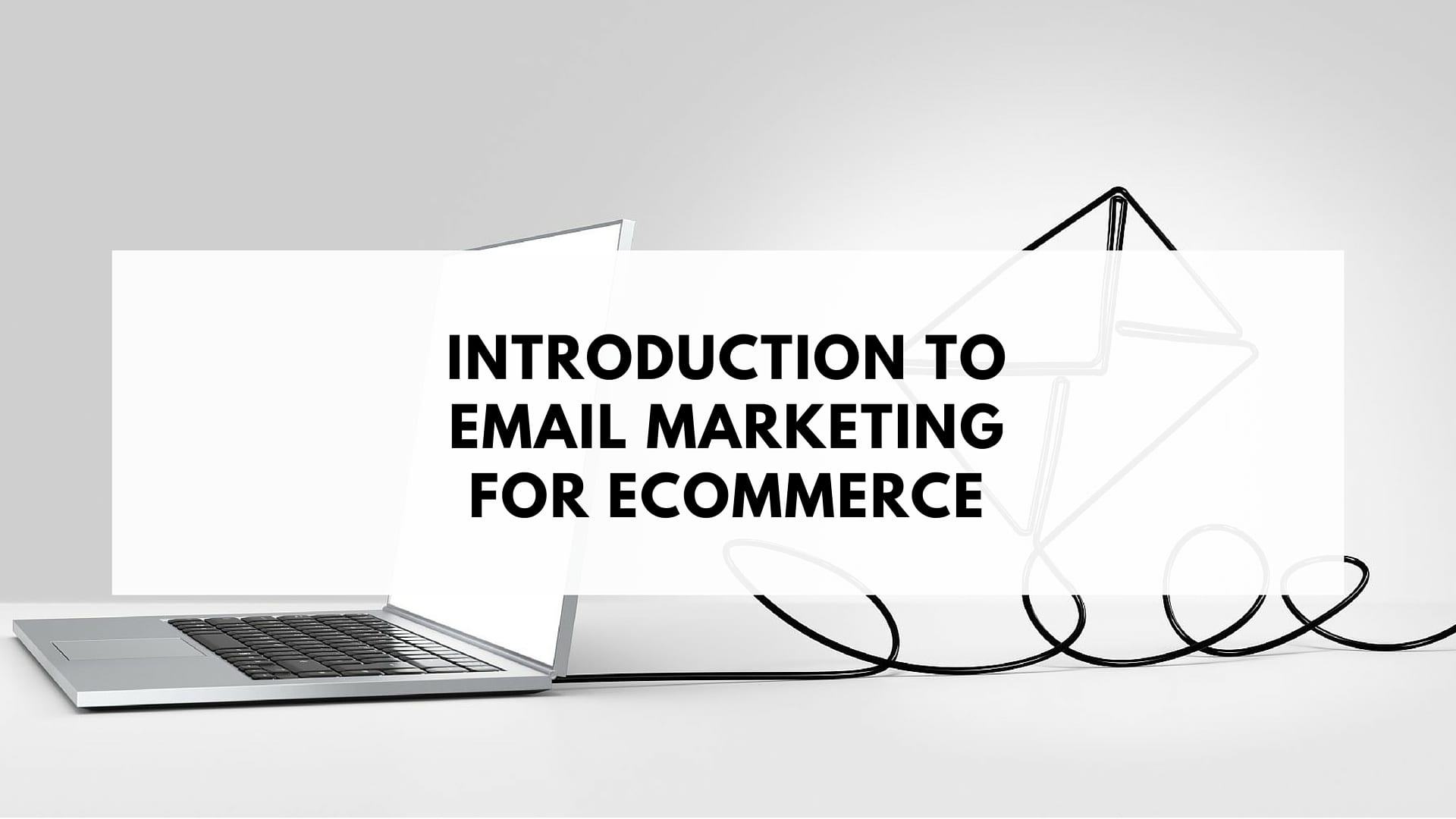If diamonds are a girl’s best friend, then email marketing ought to be a jeweler’s best friend. Nailing the marketing for jewelry within your store off the bat is exceptionally important.
While it might sound like girls get the better friend with diamonds, trust me, what email marketing lacks in glamor it makes up for in results.
When your jewelry email marketing plan is executed well, it’ll be more valuable than any diamond you have on offer too.
And while many jewelers and jewelry retailers put off developing an email marketing strategy out of fear of it being too hard, it’s a fairly straightforward process.
There’s no reason why any jewelry shop, no matter how small, can’t find success with email marketing.
That’s why we’ve created this guide: To take you through, step-by-step, how you can implement email marketing for your jewelry business.
We’ll cover every step from choosing an email app, building your email list, ideas for emails, and how you can save time through automation that’ll drive sales with virtually no ongoing work from you.
We’ll also include plenty of email examples and show you how you can make your own emails sparkle like your own pieces of jewelry.
Why email?
As you’re reading this guide, it’s safe to assume that you either want to set up email marketing for your jewelry store, or you’re looking to improve your current strategy to stay on top of things.
Either way, you might have some lingering thoughts about whether email is worthwhile.
After all, there are plenty of newer social media channels like Instagram and Pinterest that let you show off high-quality images of your products through a highly visual medium.
Email, however, has a few not-so-obvious aces up its sleeve.
You own your email list
Just like how your following on Instagram or Facebook is the foundation of your social media marketing, your email list is the foundation of your email marketing.
But there’s a big difference between your followings on social media and your email list: You own your email list.
Social media platforms, on the other hand, control how you can interact and communicate with your audience. And if you’ve done any social media marketing, you know these platforms exert this control over advertisers.
On Facebook, for example, the average percentage of organic post engagement for a page is as low as 2.27%, and on Instagram, it’s lower than 1%.
If you want more of your audience to see your posts, you have to pay up to sponsor posts or run paid ads.
Nobody, however, owns email. Email is an open protocol, meaning that when you send your email newsletter, it’s sent to your entire email list.
Unlike social media engagement, nearly 20% of the average retailer’s email list opens and engages with email campaigns.
Email is a direct line of communication
Any successful business in any field is built by identifying a target audience of potential customers, engaging them to convert them into buyers, and then maintaining that relationship to build loyalty.
Email provides the perfect means to achieve this as it provides you with a direct line of communication with your audience.
As we’ll explore later on, you can also tailor your email messages to people at every stage of the customer journey. This is something you can’t do with traditional advertising campaigns like in print or TV and is much harder to achieve with other digital marketing channels.
This unrivaled ability to target your messaging to particular audiences is a large part of why email has the highest return on investment of any marketing channel.
In fact, a Direct Marketing Association study found every dollar invested into email generated an average of $43.62 in returns.
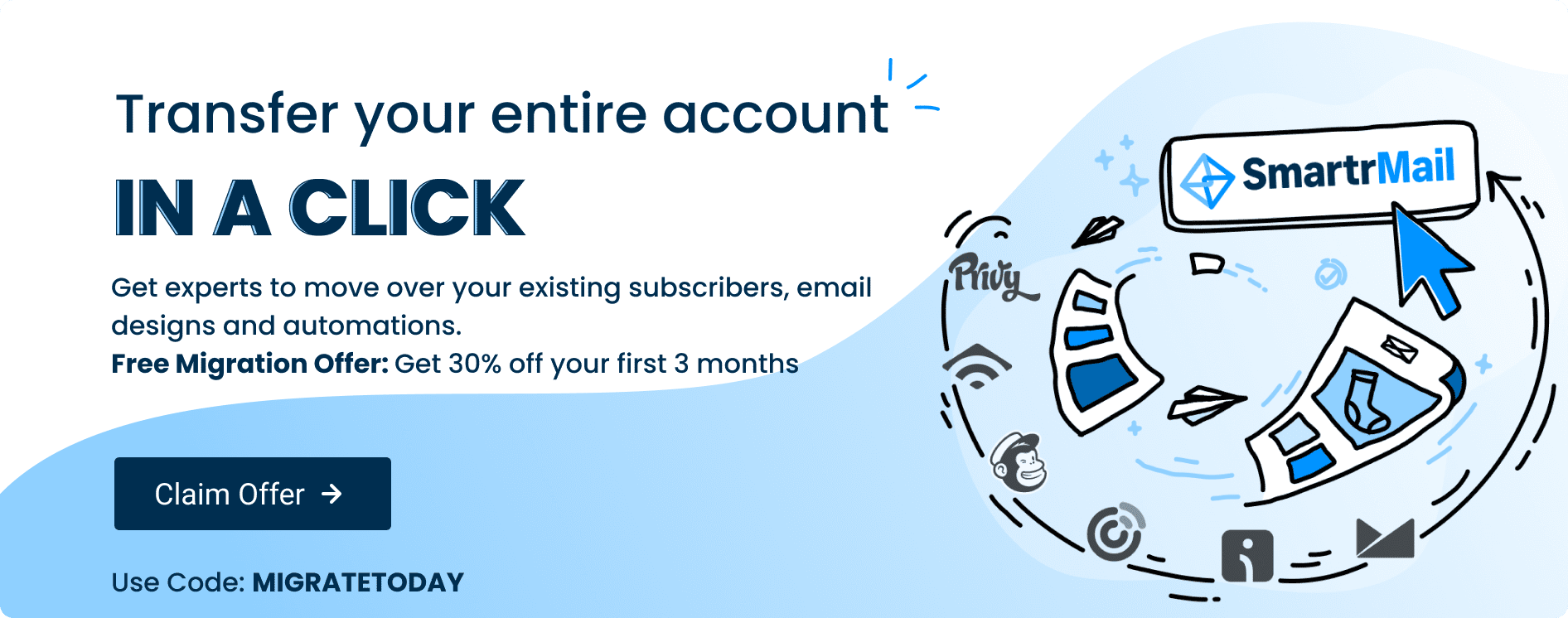
Customers prefer email
Over two-thirds of Americans have stated they prefer hearing from businesses through email.
Compare this to just 17% who stated they prefer social media.
People also enjoy receiving email marketing from jewelry stores, with people opting into receiving emails from jewelry at a higher rate than any other industry.
Developing your jewelry email marketing plan
Now that you know why email marketing is an essential part of any successful jewelry marketing plan, we can get into the steps to setting up your email marketing strategy.
1) Choose an email service provider
If you’re new to email marketing and haven’t set anything up yet, your first step is to choose an email service provider, or ESP for short.
An ESP is essentially just a marketing app that lets you store your contacts, design and create emails, and send out campaigns.
There are plenty of options out there, too, including SmartrMail if you use an ecommerce platform like Shopify or WooCommerce.
Regardless of which ESP you choose to go with, there are a few things you’ll want to look for:
- The ability to segment your list. That is, divide your email list into segments of people based on factors like whether they’ve purchased an engagement ring or whether they shop at your store in the lead-up to Valentine’s Day, which will let you send targeted messaging later down the track.
- A variety of email capture options, such as popups and customizable forms, so that you can grow your email list.
- The ability to automate emails (which we’ll cover later) so you don’t have to send every email manually.
- The ability to integrate with the ecommerce platform you use for any online part of your store.
- Customer support, preferably with a live chat option. This is something you’ll definitely come to appreciate if you’ve never sent an email campaign before.
2) Build your email list
Once you’ve chosen an ESP and got your set up and acquainted with the app, it’s time to start collecting email addresses.
When adding people to your email list, it’s important only to add people who have actively agreed to receive marketing emails from you.
Sending marketing campaigns to people who didn’t opt-in to your email list can constitute a violation of their privacy and breaches regulations like CAN-SPAM. It can also land your emails into people’s spam folders instead of their inboxes.
So how do you get people to join your email list?
It’s all about your opt-in incentive.
What is an opt-in incentive?
An opt-in incentive is simply what you offer people to encourage them to sign up to your email list. For example, if you offer people a 5% off coupon if they sign up to your email list, that would be your opt-in incentive.
As you can probably relate to, people already receive plenty of emails, so they tend to be selective about signing up to email lists unless they think they’re going to get value out of doing so.
This is why providing an opt-in incentive is important. It’s a way to demonstrate to people that they’ll receive value from signing up to your list.
Get Started with Jewelry store templates with SmartrMail!
? Install SmartrMail and automate your emails today?
Creating an enticing opt-in incentive
So what should your opt-in incentive be?
While a coupon for a certain percentage discount will get people signing up, there are plenty of other non-monetary options as well if you don’t want to discount your jewelry.
Many jewelers will simply promise to keep people up-to-date with their latest news and while this type of opt-in incentive doesn’t cost them anything, it’s not particularly enticing either.
Remember that the goal of your incentive is to convince potential customers that there’s value to being on your list.
With that in mind, here are a few opt-in incentive ideas you might want to consider:
- Provide style inspiration in the form of a lookbook that subscribers can download.
- Provide gift guides in the lead-up to events like Valentine’s Day, Mother’s Day, and Christmas.
- Access to sneak peeks on upcoming designs and first dibs on new releases.
Once you’ve created an opt-in incentive that makes sense for your store, you then start letting people know about it. The more people who know about your email list and your incentive, the more people who will sign up.
Tell customers in your store
The most obvious way to let people know about your email list and opt-in incentive is simply to tell them about it.
You can do this by telling people as they browse your store or after they make a purchase.
To avoid coming across the wrong way, you’ll want to avoid mentioning your email list as soon as they walk through your door. Instead, you should wait until you’ve had a chance to determine whether they’d be receptive to hearing about your email list and if you think they’d be interested.
Don’t feel like you have to tell everyone about your list either; not everyone is going to want to sign up, and that’s okay. You only want people who are genuinely interested in your list anyway.
Include a way to sign up for your other marketing campaigns
If you run other marketing campaigns for your jewelry store, like ads in magazines or in newspapers, you might want to consider mentioning your email list in it.
Of course, people can’t sign up directly through a print ad. So you’ll need to include the website address of a landing page where people can sign up.
Any good ESP will let you easily create these pages or embed a signup form on your existing website.
As web addresses are not the most attractive forms of text, you might also want to use a URL shortener so that it doesn’t take up as much space.
Another option is to include a QR code instead so that people simply just need to scan your ad with their phone. This saves them from having to type in an address and improves their experience.
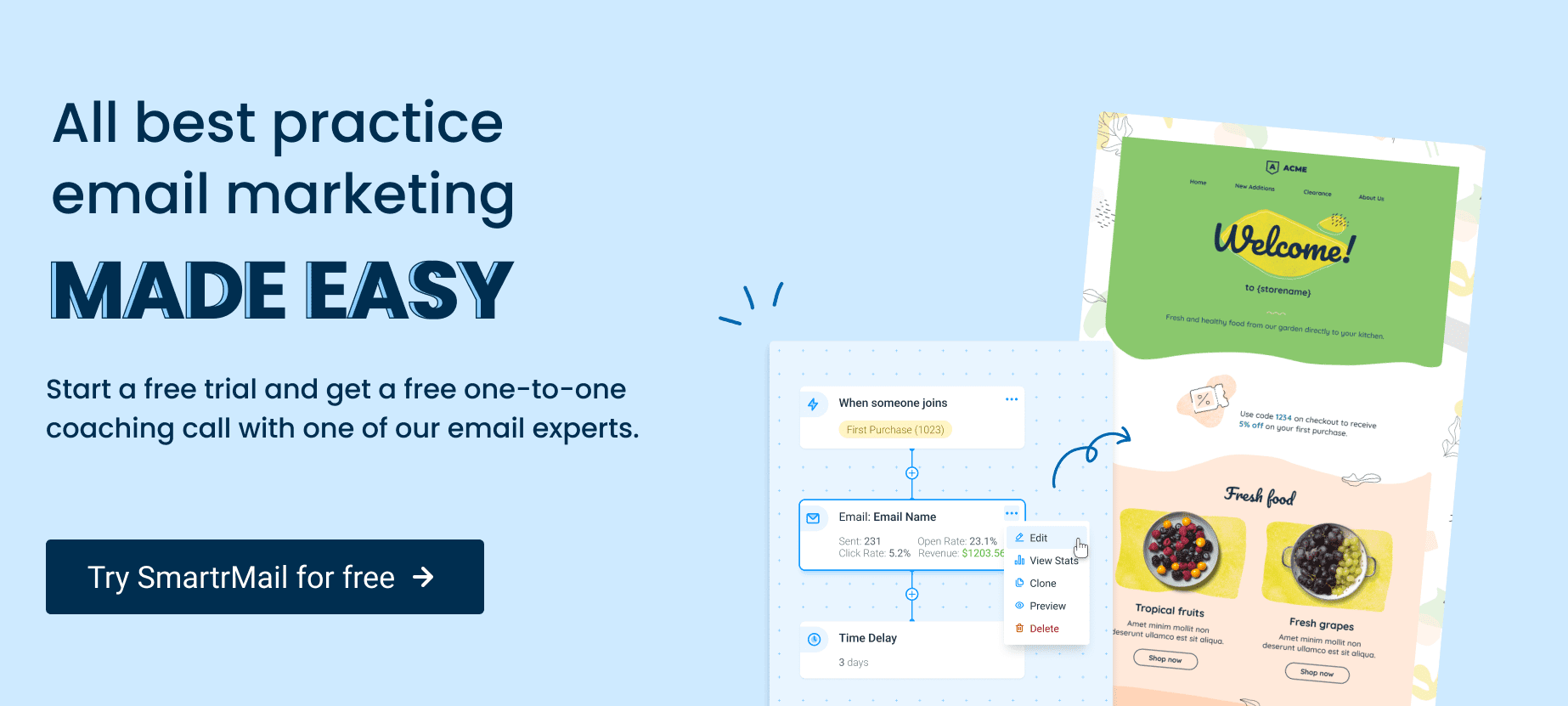
Take advantage of traffic to your online store
If you also run an online store, or if your jewelry store is entirely online, you’ll want to highlight your opt-in incentive to your website visitors.
Even if you simply just have a website with no commerce functionality, adding a simple form for people to sign up to your email list is an obvious thing to do.
There are a few main ways to do this:
- With popups that grab people’s attention when they visit your site
- Whole dedicated pages devoted to explaining the value of your opt-in incentive (these are known as landing pages)
- Simple email forms in the footer or sidebar of your site that aren’t intrusive and in-your-face like popups, but are still visible. Like in the example below from Tiffany & Co.
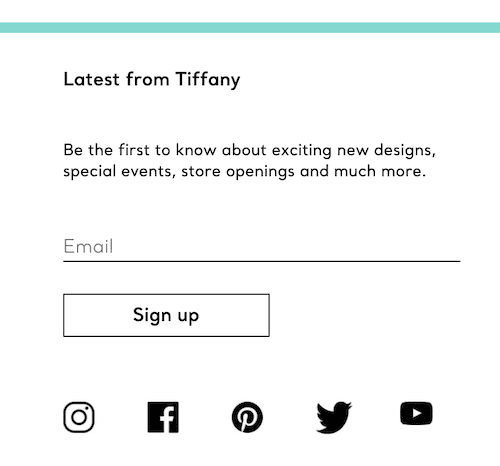
Growing a healthy email list
A final word on growing your email list.
The more you start advertising your opt-in incentive and email list, the faster you’ll start collecting email addresses.
However, keep in mind that a strong email list is not something that appears overnight. Instead, a healthy list is something that grows gradually, but consistently over time and contains people genuinely interested in receiving your emails.
It’s for this reason that it’s important to start growing your email list as soon as possible, but also be careful about adding people who will get value from your emails.
If you grow your list rapidly by adding just anyone to it, people won’t engage with your emails, and the effectiveness of your campaigns will suffer as a result.
3) Setting up email automation
Once you’ve started building your email list, it’s time to start sending emails to engage your subscribers.
There’s no number of subscribers you need before you should start sending emails.
If you wait until you have a certain sized list, by the time you achieve your arbitrary goal your early subscribers may have lost interest in your store.
One of the primary aims of your email marketing should be to engage potential customers and maintain relationships with existing ones.
To do this, you should be sending emails out on a regular basis as soon as you’ve collected your first subscriber.
And the first step to doing this is to set up some email automation that’ll send automatically when people sign up to your email list and engage in other behaviors like making a purchase.
The good thing about these automations is that once they’re set up, they require almost no ongoing effort apart from the occasional review to make sure they’re still relevant.
Welcome emails
Welcome emails are simply emails that are sent to people immediately after joining your email list.
This doesn’t have to be a single email, either.
The most successful email marketing strategies utilize multiple emails in their welcome ‘series’ to help nurture new connections.
Because of this, it’s a common strategy to set up two separate welcome email series: one for new customers and one for people who have signed up to your email list but haven’t yet made a purchase.
If someone hasn’t purchased before, they’ve likely signed up because of your opt-in incentive.
This means the first welcome email they receive should thank them for signing up and delivering what you promised them. Like in the example below from Molten Store, where they provide the promised $20 credit voucher.

If someone has opted into your email marketing as they were checking out an online order, then the first welcome message should be to thank them for their purchase. Like Hudson’s Bay email below.
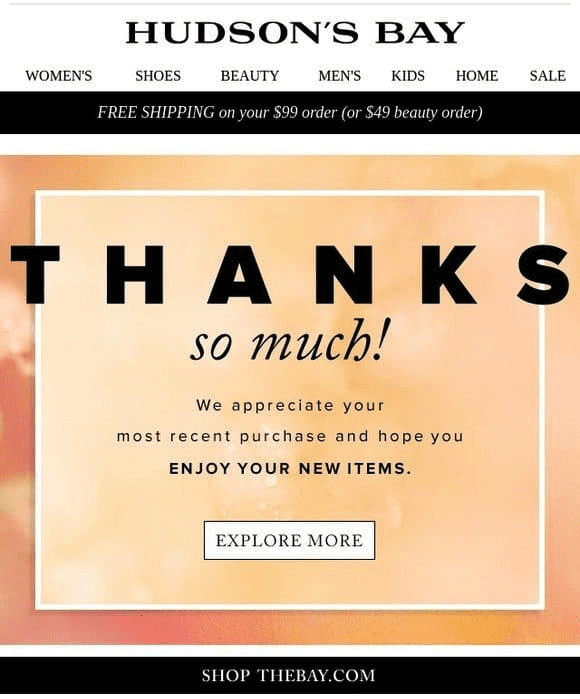
You can view more examples of thank you for your purchase emails here.
After the initial welcome emails (which should be automated to send immediately after someone joins your list in both cases), you should follow up with a few more emails.
These emails will again differ slightly depending on whether someone has made a purchase or not.
For people who haven’t made a purchase yet, the emails should nudge them toward making their first purchase. Whereas if they are already a customer, you can be more gentle in trying to make a sale.
In both cases however, you’ll want to build your brand image by dedicating emails to the following potential themes:
- Introducing your brand values and design philosophy
- Talk about where your jewelry comes from (whether you craft any of it yourself, where your diamonds and other gemstones are sourced, etc.)
- The history of your jewelry business (you can even introduce yourself as the owner to add a personal touch)
- Details and photos of your physical store if you have one (where it’s located, opening hours, etc.; this is particularly relevant if someone has made a purchase online)
For both segments of customers, you’ll also want to space these emails out over increasing intervals. A good way to do this is to:
- Send the second welcome email 24-48 hours after someone joins,
- Send the third 3-5 days after the second,
- Send a fourth one to two weeks after the third.
You can learn more about welcome emails here and learn how to set up them in SmartrMail here.
Sign-up to our newsletter and receive a free eBook with hidden Email Marketing Tips
Abandoned cart recovery
Abandoned cart emails are only applicable if you sell your jewelry online, and if you do, they’re absolutely essential email automation.
When it comes to people shopping through online stores, for every three customers who add a product to their shopping cart, only one will actually make a purchase. The other two are said to have ‘abandoned’ their carts.
Online shopping cart abandonment is a major problem for every online retailer, not just jewelers. Trillions of dollars worth of products are left in abandoned carts globally every year.
The good news is that over a third of these otherwise lost sales can be recovered with an abandoned cart email like the one below from Monica Vinader.
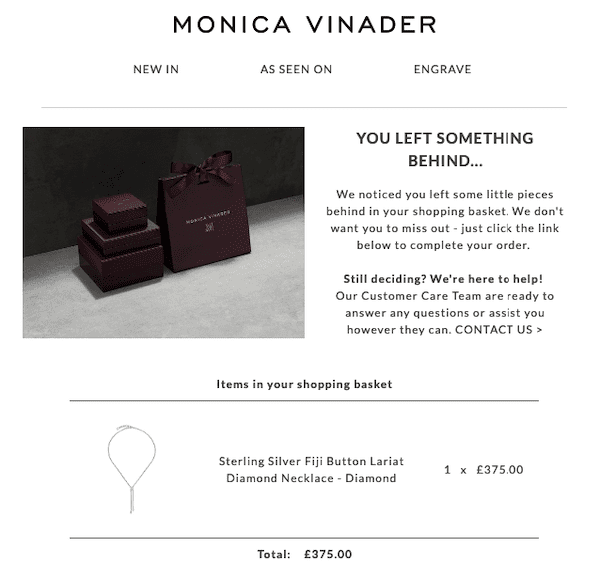
These emails are also very easy to set up and enable.
Ecommerce platforms like Shopify let you enable these automatic emails in literally just a few clicks.
However, if you want more control over how these emails appear and function (such as the timing between when a customer abandons their cart and when they receive a reminder), you will need to use an email service provider that offers this functionality.
You can learn more about setting up and customizing cart recovery emails in SmartrMail here.
Cross-sell recommendations
Cross-selling is when you recommend a customer a similar product to what they have just purchased.
A jewelry example would be recommending matching earrings based on a necklace someone recently bought.
While you might already be doing this with in-store customers, the beauty of email marketing is that this process can be fully automated for all customers, including those purchasing from your online store who you never see.
To set up these emails, you first need to take a look at your catalog and identify suitable pairings.
Once you have these pairings, you create an email outlining why the recommended product would go great with the original purchase. You then automate this email to trigger after someone makes the appropriate purchase.
You can find detailed instructions on setting up these automation in SmartrMail here.
If you have a large product collection where setting up these pairings would be impractical, you can cross-sell based on product category instead.
For example, instead of recommending a particular set of earrings for a particular necklace, if someone purchases a gold necklace, you can recommend a range of gold earrings for them to choose from.
Winback emails
It’s inevitable that some of your even most loyal repeat purchasers are going to go cold and stop purchasing jewelry from you.
Thankfully, win back email automation help bring these customers back to your jewelry store.
These emails attempt to ‘win back’ customers by sending a customer who hasn’t made a purchase recently an email.
For example, you can set it up so that high-value customers (i.e., those who have spent over a certain amount) receive the email after 12 months (as this may coincide with an event like an anniversary or birthday) have passed without a purchase.
Just like in the example below from Astley Clark, these emails typically contain a special offer or message to entice the customer back.
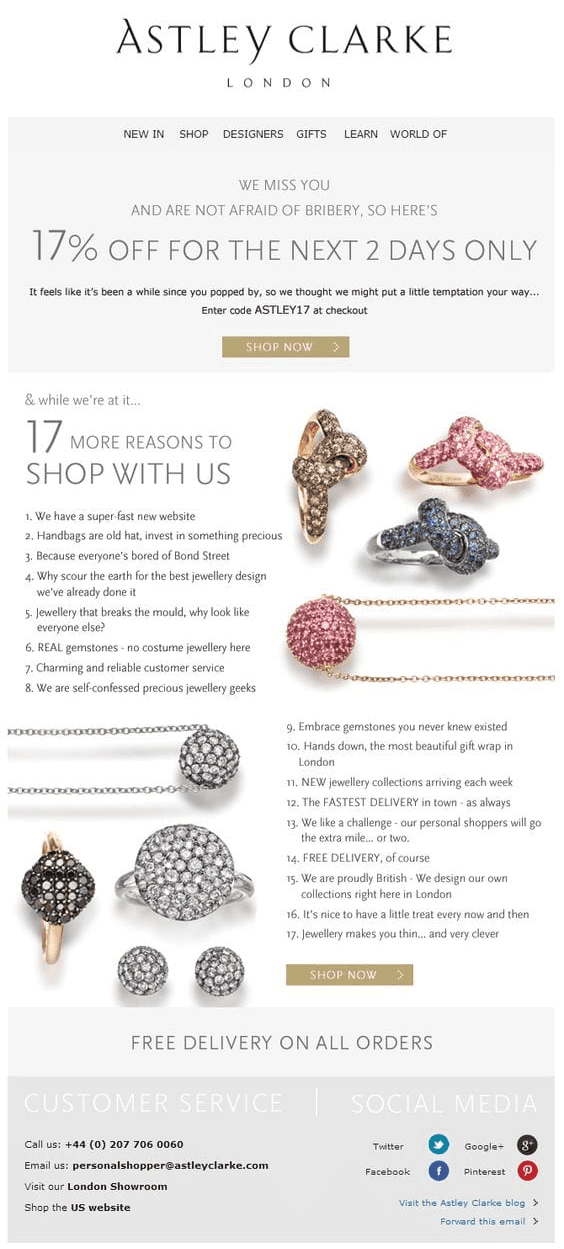
These emails will help you retain customers as well as generate sales, all without any ongoing effort from you.
You can view more examples of win back emails here. You can also learn how to set up winback emails in SmartrMail here.

Other marketing automation you can set up for your jewelry store
The email automations mentioned so far are relevant for every jewelry store and will help bring in the most additional revenue.
There are, however, plenty of other types of email automation that you can set up that we don’t have room to cover here. Especially if you run an online store which will give you a lot more data to work with.
Some other automation you might want to consider include:
- Birthday emails that give people a reward for their birthday. (You can learn how to automate birthday emails in SmartrMail here).
- Personalized product recommendation emails that look at your store’s data to determine which products customers are most likely to be interested in.
- Milestone emails where you automate a special email to send every year (or however often) since someone has joined your email list.
4) Come up with email marketing ideas for your jewelry store
After you’ve started to grow your email list and set up all of the best practice automation, you’ve done most of the work in establishing an email marketing strategy.
The last step, however, is an ongoing task: to send regular, engaging email newsletters.
By sending regular newsletters, you’ll keep your existing and potential customers engaged with your brand. When they decide to buy some jewelry, your jewelry business will be top of mind.
While it’s hard to tell you exactly how often you should send your subscribers a newsletter, anywhere from once a week to once a month is usually fine.
Any more frequently, you risk annoying people and having them unsubscribe, and any less frequently, the connections you build with your customers will start to fade.
If you’re wondering what you should include in your email newsletters, here are some ideas for content.
Introduce new items
An email newsletter is a great way to spread the word about any new jewelry ranges or offerings you have.
Just like in the example below from Monica Vinader.
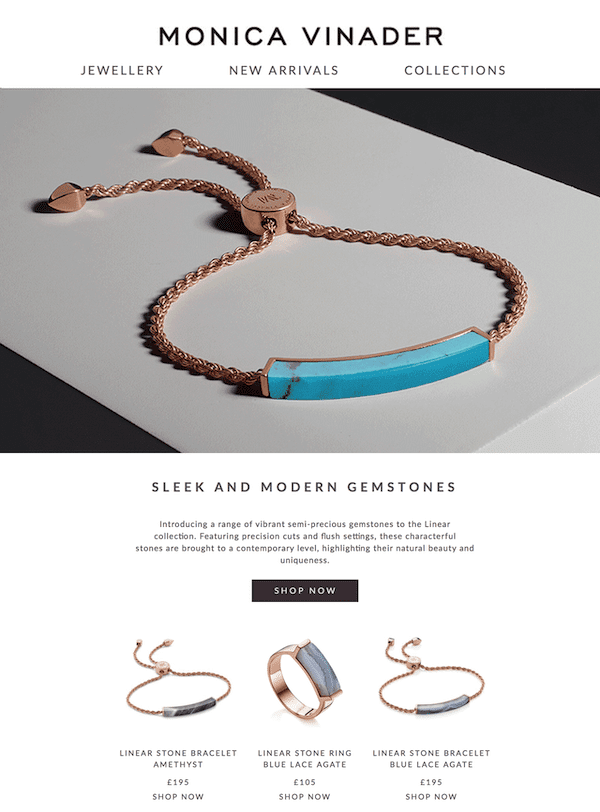
You can even segment high-value customers out and send them a ‘sneak peek’ first to show that you value their business before announcing the items to everyone on your email list.
Sale events
Sending a newsletter to your subscribers about your sale is the single easiest and yet most effective thing you can do to ensure your sale is a success.
You can even hold sales exclusive for your subscribers as Molten Store has done.
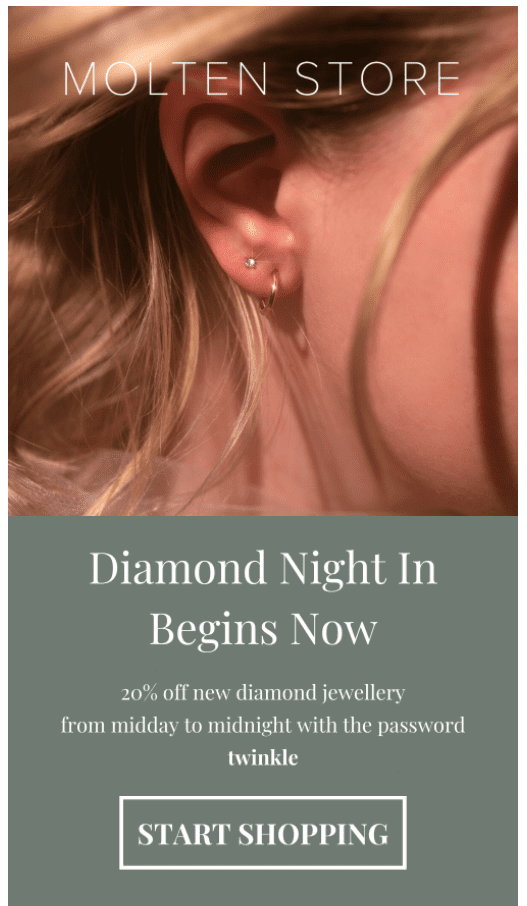
Providing people with a password to unlock the savings makes the sale feel even more exclusive. The midday to midnight time constraint also generates a sense of urgency which helps to compel people to make a purchase.
Themed email collections
There are multiple themes you can jewelry collections on: modern, traditional, jewelry with a particular gemstone, animal, or design motif, etc.
For instance, you can dedicate a newsletter to a particular color, as 1928 Jewelry has done.
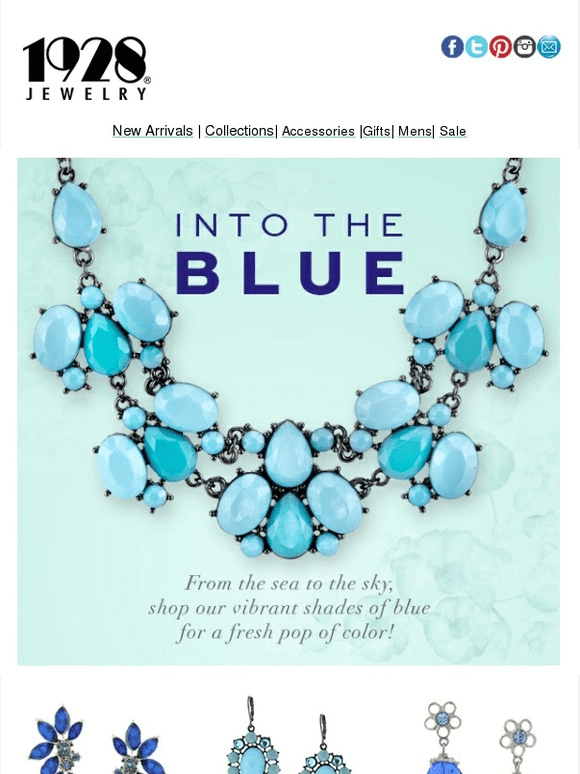
Seasonal newsletters
The beginning of a new season, like spring or summer, or even the beginning of a new month of the zodiac, is a perfect opportunity to create a collection of jewelry for a newsletter.
You can even combine this with a new season sale, just like in the email below.
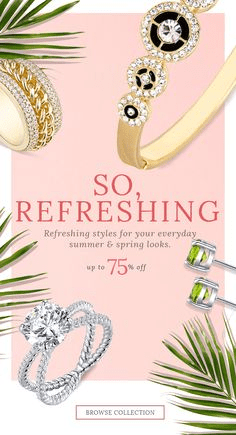
Holidays
Valentine’s Day may be the quintessential holiday for jewelers but there are plenty of other holidays you can create an email newsletter for, including:
- Valentine’s Day
- Mother’s Day
- Christmas
- Chinese New Year
- St. Patrick’s Day (good opportunity to showcase a collection of green jewelry)
Some jewelers even take advantage of Halloween in their email marketing.
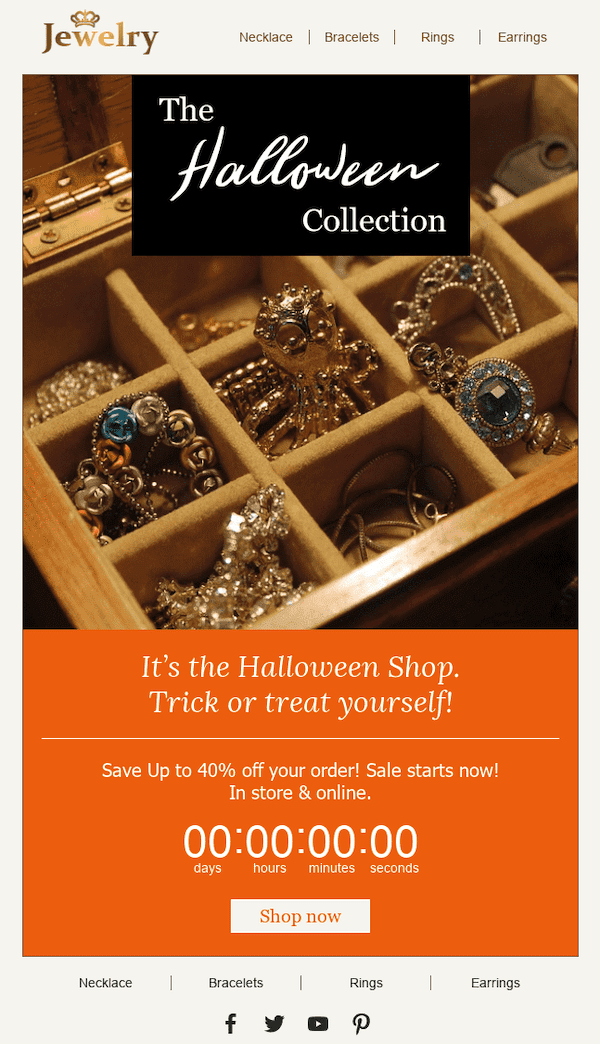
While you’ll almost certainly want to send a series of email newsletters out in the lead up to Valentine’s Day, it’s up to you which other holidays you opt to use in your newsletters.
Jewelry email marketing examples
Now that you have a firm understanding of email marketing for jewelry retailers, it’s time to get inspired by examples of emails from other jewelry companies.
You can use any inspiration you find here to give your own campaigns that extra sparkle.
Stella & Dot
Aligning your jewelry sale with a charitable cause is a great way to increase the number of conversions. Especially when you’re offering limited edition jewelry that matches the cause like Stella & Dot.

Francesca’s
Jewelry is something that needs to be seen, that’s why it’s important to include high-quality imagery in your campaigns like Francesca’s has done.
Include images of models wearing your jewelry will also help people visualize themselves wearing it.
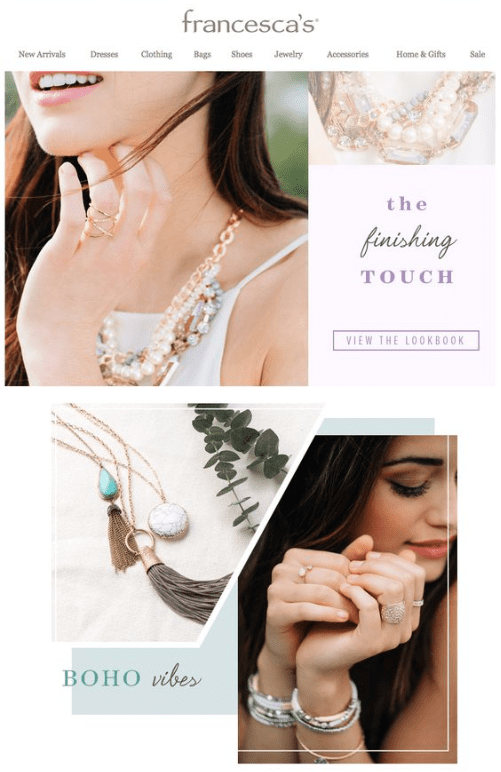
Tiffany & Co.
The use of a gift box in Tiffany & Co.’s welcome email is a nice visual metaphor of receiving something of value in one’s inbox.
The teal color also helps to reinforce Tiffany & Co.’s branding.
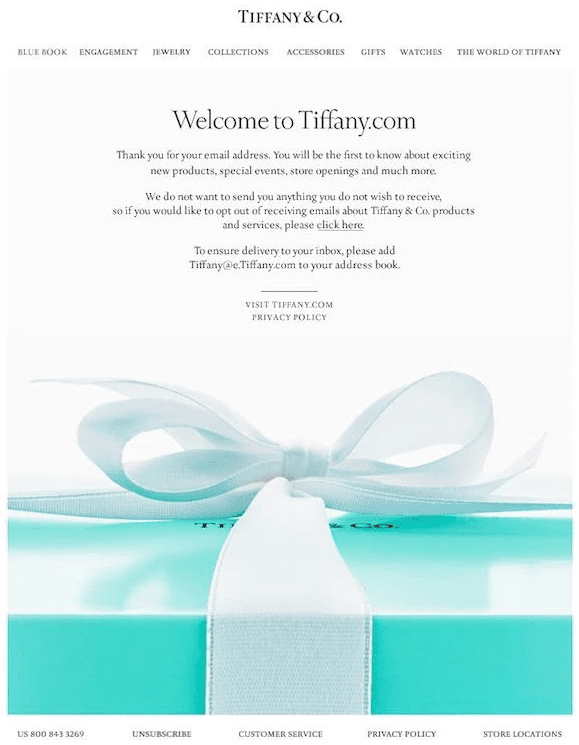
Valentine’s Day email
If you’re looking for some Valentine’s Day email inspiration, this email from Kate Spade is a good example of one.
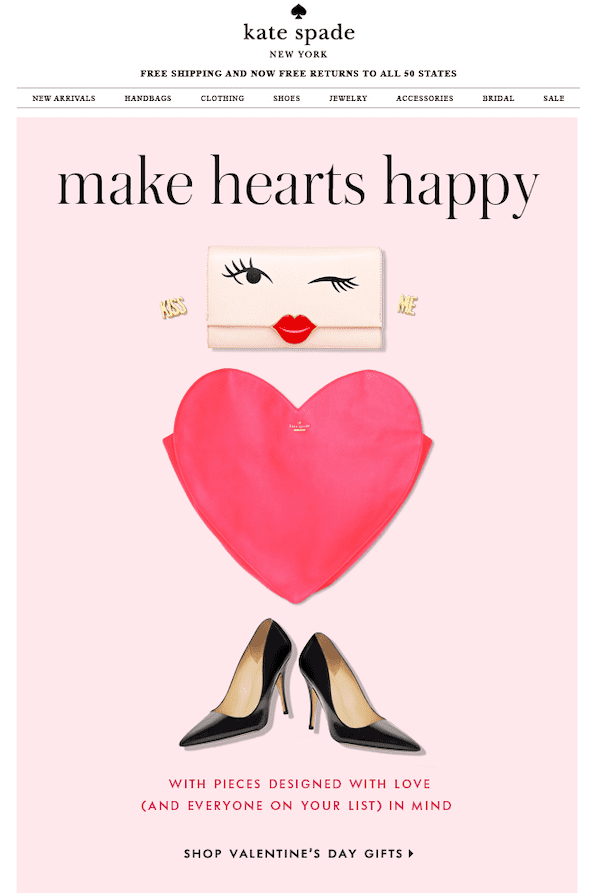
It’s clean, simple, and elegant. The one thing that could be improved is making the link at the bottom that’s inviting people to ‘Shop Valentine’s Day Gift’ more obvious by having it look like a button.
Conclusion
Email marketing for your jewelry store is fairly straightforward and simple when you know what to do.
All it comes down to is collecting email addresses, setting up automation, and sending engaging newsletters. And of those three, the first two are largely the only things you need to involve yourself with when setting up your email marketing strategy.
While your newsletters are an ongoing task, once you find what content works best for your store, you’ll find the process will become a lot more natural.
And as you can now hopefully appreciate, email marketing delivers the greatest return of any marketing channel, is the best at both acquiring and retaining customers and is largely automated once you have it up and running.
All of this makes email something you cannot let your jewelry business go without.

